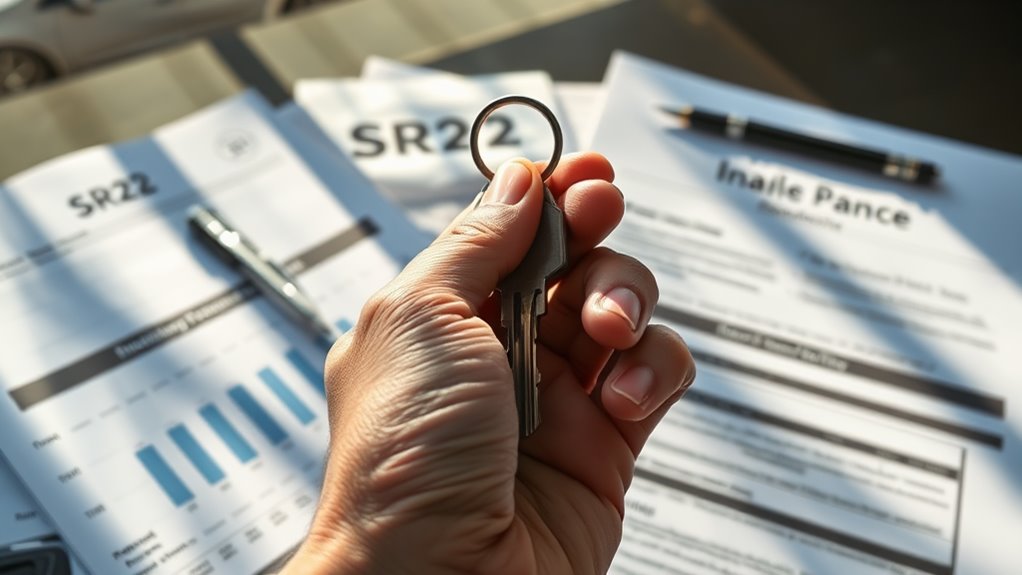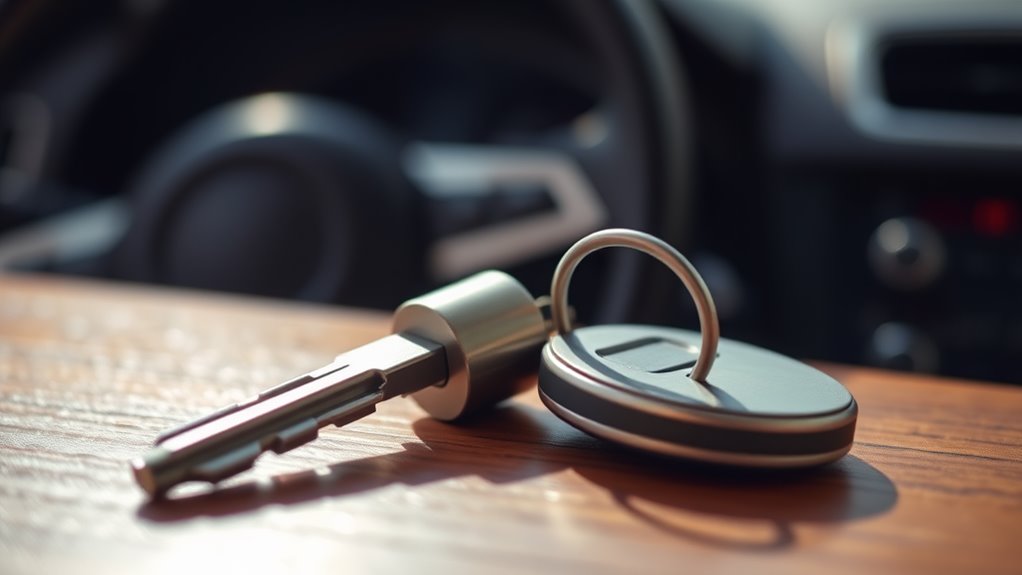Do you really know what SR22 insurance entails? Many believe it's just another insurance policy, but it's actually a certificate of financial responsibility required by states for high-risk drivers. Understanding this distinction, along with the specific requirements in your state, can save you time and money. As you explore your options, you'll uncover essential tips that can help you navigate the complexities of SR22 coverage effectively.
Key Takeaways
- Understand that SR22 is not insurance but a certificate verifying financial responsibility required after certain violations.
- Compare quotes from multiple insurers to find the best rates, as costs can vary significantly among providers.
- Explore different types of SR22 policies to determine which suits your needs: owner, non-owner, or operator policies.
- Make use of discounts for safe driving, bundling policies, or completing defensive driving courses to lower premiums.
- Ensure timely SR22 filing with your state's DMV to avoid license suspension due to lapses in coverage.
Understanding the Purpose of SR22 Insurance

Understanding the purpose of SR22 insurance is vital for anyone needing to reinstate their driving privileges after certain offenses.
SR22 isn't an insurance policy; it's a certificate of financial responsibility that verifies your compliance with state minimum liability insurance requirements. This document is important for regaining your driving rights, as it confirms you have the necessary liability coverage in place. While SR22 doesn't provide additional coverage, it guarantees you meet state mandates. Requirements can vary by state, but generally, you'll need to maintain this coverage for a set period. In Ohio, SR-22 insurance requirements typically last for three years, depending on the offense. If you fail to comply or if your policy lapses, your state will be notified, potentially leading to a license suspension. Maintaining continuous insurance coverage is key to keeping your driving privileges intact.
Identifying Who Needs SR22 Coverage
Who really needs SR22 coverage? If you've faced certain driving offenses or violations, you might be required to obtain an SR22.
Here are some common scenarios that trigger the need for this coverage:
Certain driving offenses, such as DUIs or serious traffic violations, can necessitate SR22 coverage.
- Convictions for driving under the influence (DUI) or driving while intoxicated (DWI)
- Serious traffic violations leading to license suspension
- Accumulation of multiple traffic infractions in a short time
- Driving without insurance, especially after an at-fault accident
- Patterns of reckless driving or endangerment
If you find yourself in any of these situations, obtaining SR22 coverage is essential for reinstating your driving privileges and ensuring compliance with state laws.
Always consult your local DMV for specific requirements that apply to your situation.
Navigating State Requirements for SR22
Maneuvering state requirements for SR22 can be complex, especially since each state has its own specific rules and regulations.
You'll need to understand that an SR22 isn't an insurance policy, but a certificate proving you meet state minimum liability requirements. These requirements vary considerably, including the duration of filing and coverage amounts.
Typically, your insurance company will file the SR22 with the state DMV, which may take over 30 days to process. Make sure your policy remains active throughout the SR22 period, as lapses can lead to severe penalties, including license suspension.
Keep in mind that SR22 filings usually last about three years, but this can differ by state, so check your local laws to stay compliant.
Exploring Different Types of SR22 Policies

Once you're familiar with state requirements for SR22, it's important to explore the different types of SR22 policies available to you.
Understanding these options can help you choose the right coverage based on your specific needs.
- Owner SR22 Policies: Covers only owned vehicles; cost-effective for primary drivers.
- Non-Owner SR22 Policies: Ideal for those who don't own vehicles but drive occasionally; cheaper coverage.
- Owner-Operator SR22 Policies: Extensive coverage for both owned and borrowed vehicles; higher premiums.
- Operator SR22 Policies: Focuses on liability for non-owned vehicles; often the most affordable option.
- Miscellaneous Options: Includes fleet SR-22 policies and discounts based on driving records.
Choose wisely to guarantee you meet legal requirements while maintaining adequate protection.
Assessing Costs and Fees Associated With SR22
While maneuvering through the complexities of SR22 insurance, it's essential to understand the costs and fees associated with it.
Typically, SR22 insurance costs more than standard policies, with average annual premiums exceeding $2,700. Factors like your driving history, the severity of your violations, and state regulations can greatly impact these costs. Premiums can rise by as much as 90% compared to regular insurance rates.
Additionally, you'll encounter a one-time SR22 filing fee ranging from $25 to $50, which is minimal compared to the increased premiums.
To manage expenses, shop around for quotes and demonstrate responsible driving behavior, as this can lead to lower rates over time.
Filing and Processing Your SR22 Form
Understanding the costs and fees tied to SR22 insurance sets the stage for grasping the filing and processing of your SR22 form.
Here's what you need to know:
- The SR22 is a certificate confirming you meet state minimum liability insurance requirements.
- Your insurance company typically files the SR22 form electronically, speeding up the process.
- There are three types of SR22 forms: owner, non-owner, and operator/owner.
- Expect a small filing fee, usually under $50, depending on your state.
- Maintaining coverage is essential; lapses can lead to penalties or license suspension.
Understanding Non-Owner SR22 Policies

If you're a high-risk driver without a vehicle, a non-owner SR22 policy can be your ticket to meeting state insurance requirements. This type of insurance provides essential liability coverage, guaranteeing you comply with the law while driving rented or borrowed vehicles.
It's particularly beneficial if you've had serious infractions like DUIs or need to reinstate a suspended license. Remember, non-owner SR22 policies don't cover vehicle damage but protect you financially in accidents.
Eligibility typically includes those without regular access to a vehicle. Costs are generally lower than traditional SR22 policies, but factors like your driving history and state laws can affect rates.
Always check local regulations to verify you're fully compliant.
Legal Implications of SR22 Non-Compliance
Failing to maintain your SR22 coverage can lead to serious legal consequences that extend beyond just losing your driving privileges.
You might face a variety of penalties that can impact your life considerably. Here's what to expect:
- License Suspension: Immediate loss of driving privileges.
- Fines and Penalties: Severe fines vary by state for non-compliance.
- Insurance Cancellation: Policies may be canceled due to lapses.
- Increased Legal Risks: Driving without SR22 coverage can expose you to financial liabilities.
- Jail Time: Possible imprisonment for repeat offenses.
Navigating these legal implications can be complex and costly.
Prioritizing your SR22 compliance is essential to avoid these serious repercussions.
Tips for Maintaining Continuous SR22 Coverage
Maintaining continuous SR22 coverage is essential to avoid legal complications and guarantee your driving privileges remain intact.
To make certain you don't experience any lapses, stay proactive about your policy. Always pay your premiums on time; missed payments can lead to coverage gaps. If you switch insurance companies, confirm the new provider files the SR22 certificate promptly.
Stay proactive with your SR22 policy by paying premiums on time and ensuring prompt filing with any new insurance provider.
Be aware of your state's specific requirements, as these can vary. If you move, check that your coverage complies with your new state's regulations.
Finally, keep track of the SR22 requirement duration, usually three years, and avoid any violations during this period. A clean record can help lower future premiums and maintain your driving rights.
Finding the Best SR22 Insurance Rates in Ohio
Wondering how to secure the best SR22 insurance rates in Ohio? Start by comparing quotes from multiple insurers.
Here are some key strategies to help you find affordable coverage:
- Shop Around: Different insurers offer varying rates for high-risk drivers.
- Look for Discounts: Ask about bundling policies or other available discounts.
- Take Defensive Driving Courses: Completing state-approved courses can lead to potential savings.
- Consider Usage-Based Insurance: These programs might offer lower rates based on your driving habits.
- Manage Your Deductibles: Raising your deductibles can lower your premiums if it fits your budget.
Conclusion
In summary, steering through SR22 insurance doesn't have to feel like climbing a mountain. By understanding the purpose, identifying your needs, and comparing policies, you can find the right coverage for your situation. Stay informed about state requirements and keep your compliance on track to avoid legal troubles. With the right approach, you'll not only meet your obligations but also potentially save money along the way. Take charge of your SR22 journey and drive with confidence!

